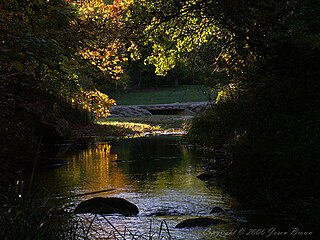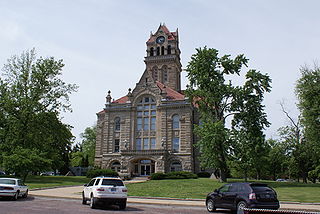Related Research Articles

Greenbrier County is a county in the U.S. state of West Virginia. As of the 2010 census, the population was 35,480. Its county seat is Lewisburg. The county was formed in 1778 from Botetourt and Montgomery counties in Virginia.

Lewisburg is a city in Greenbrier County, West Virginia, United States. The population was 3,830 at the 2010 census. It is the county seat of Greenbrier County.

Chickasaw National Recreation Area is a national recreation area in the foothills of the Arbuckle Mountains in south-central Oklahoma near Sulphur in Murray County. It includes the former Platt National Park and Arbuckle Recreation Area.

Architect John Ariss (1725–1799) was born in Westmoreland County, Virginia to a family long settled in the Old Dominion. Two of his works have been classified as National Historic Landmarks. A rare surviving, documented example of his work is Traveller's Rest in Kearneysville, West Virginia, which he designed as a farmstead home for American Revolutionary War General Horatio Gates. He is also believed to have designed the Neo-Palladian estate Mount Airy, located in Richmond County, Virginia on Virginia's Northern Neck.

Salt Sulphur Springs is an unincorporated community in Monroe County, West Virginia, United States. Salt Sulphur Springs is located on U.S. Route 219, southwest of Union.

William Christmas Knighton was an American architect best known for his work in Oregon. Knighton designed the Governor Hotel in Portland, Johnson Hall at the University of Oregon, and the Oregon Supreme Court Building and Deepwood Estate in Salem. He served as Oregon's first State Architect from 1911–1915, appointed by Governor Oswald West. By 1915, Knighton had designed ninety building projects as State Architect. In 1919, Knighton was appointed by Governor Ben Olcott as the first President of the Oregon State Board of Architectural Examiners, a position he held until 1922. In 1920, Knighton was elected the sixth President of the Oregon Chapter of the American Institute of Architects. He remained on the Chapter's Board of the Trustees for several years and was Chair of the Chapter Legislative Committee into the 1930s.

Canton Bridge Company was a firm that was later incorporated into the American Bridge Company. The firm was established in Canton, Ohio in 1892 and became one of the nation's biggest bridge-builders during the early 20th century. It designed and/or built many bridges that later became listed on the U.S. National Register of Historic Places (NRHP).
Nathan Vaught was a builder in Tennessee who was responsible for several noteworthy buildings.
Architects of the United States Forest Service are credited with the design of many buildings and other structures in National Forests. Some of these are listed on the National Register of Historic Places due to the significance of their architecture. A number of these architectural works are attributed to architectural groups within the Forest Service rather than to any individual architect. Architecture groups or sections were formed within engineering divisions of many of the regional offices of the Forest Service and developed regional styles.

Alexander W. Arbuckle I House, also known as the Michael Baker House, is a historic home located near Lewisburg, Greenbrier County, West Virginia. It was built in 1822, and is a two-story, brick "T"-shaped residence with Greek Revival style influences. It features a two-story portico with four plastered round columns and Chinese Chippendale style railings.

Morlunda, also known as the Col. Samuel McClung Place and Oscar Nelson Farm, is a historic home located near Lewisburg, Greenbrier County, West Virginia. It was built in 1827–1828, and consists of a main house with ell. The main house is a two-story brick building measuring 56 feet long and 21 feet deep. The ell measures 48 feet and it connects to a 1 1/2 story formerly detached kitchen.

Mountain Home, also known as Locust Hill and Robert Dickson House, is a historic home located near White Sulphur Springs, Greenbrier County, West Virginia. It was built about 1833, and is a large, two-story brick dwelling with a kitchen ell. It features a two-story, one-bay lunette-adorned pediment with plastered brick Doric order paired columns. It has Late Federal and Roman Revival elements on both the exterior and interior.

Greenbrier County Courthouse is a historic courthouse building located at Lewisburg, Greenbrier County, West Virginia. In 1973 the courthouse and the adjacent spring house, the Lewis Spring, were listed on the National Register of Historic Places. and are a historic and
Standard Bridge Company was an American bridge company that was "one of the most important bridge building firms in Nebraska history."

Caldwell & Drake was a construction firm based in Indiana. It included George W. Caldwell and Lester Drake.

Everett S. Sherman (1831-1897) was a covered bridge builder in Ohio. He lived and built bridges in Delaware County then moved to Preble County after a storm destroyed many of its bridges.

Jamieson Kirkwood Parker was an American government administrator and architect from Oregon, working primarily in Portland and Salem. He worked as an architect for the better part of two decades, before changing to federal and state government work, culminating in his serving as director of the Oregon division of the Federal Housing Administration from mid-1935 until his death in late 1939.
Louis H. Asbury (1877–1975) was an American architect, a leading architect of Charlotte, North Carolina. He is asserted to be the "first professionally trained, fulltime architect in North Carolina who was born and practiced in the state."

Carl L. Linde was a German American architect prominent in the Pacific Northwest of the United States, particularly in Portland, Oregon. Several of his works are listed on the National Register of Historic Places.
William Frederick McCaw (1850–1923) was an Irish born Canadian-American architect who worked in Toronto early in his career, then in the Pacific Northwest of the U.S., and then other areas in the U.S. He worked in a long succession of partnerships with various architects.